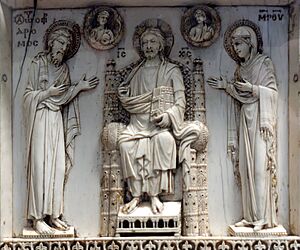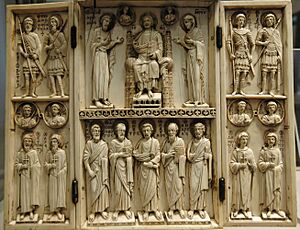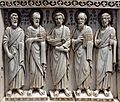Harbaville Triptych facts for kids

The Harbaville Triptych is a very special piece of Byzantine art. It's a small, three-part carving made from ivory around the middle of the 10th century. Today, you can see it in the famous Louvre museum in Paris, France. This artwork shows Deesis (a scene with Christ, Mary, and John the Baptist) along with other important saints. It's considered one of the most beautiful and well-preserved ivory carvings from its time.
Contents
What is the Harbaville Triptych?
The Harbaville Triptych is like a mini-altarpiece that folds. It's called a "triptych" because it has three panels joined together. The middle panel is larger, and two side panels can fold over it, like doors. This particular triptych was carved from ivory, which is a hard, white material from animal tusks.
A Masterpiece from Constantinople
This amazing artwork was created during the Byzantine Empire. The Byzantine Empire was a powerful civilization centered in Constantinople (modern-day Istanbul, Turkey). Artists there were known for their detailed and elegant work. The Harbaville Triptych is thought to have come from a workshop in Constantinople. This workshop was probably very close to the Imperial Court, meaning it made art for the emperor and his family.
The "Romanos Group"
The Harbaville Triptych is part of a special collection of ivory carvings called the "Romanos group." This group gets its name from another famous ivory plaque. That plaque shows an emperor named Romanos being crowned by Christ. Historians think this Romanos might have been Romanos II, who became emperor in 959.
These ivory carvings are very important for understanding Byzantine art. Many more ivories have survived from this period than paintings. This means they give us a great look into the art style of the time. The Harbaville Triptych is considered the best of the "Romanos group." It shows incredible elegance and delicate details that make it stand out.
What Does the Triptych Look Like?
The Harbaville Triptych is carved on all its sides. The front of the central panel shows the Deesis. This is a traditional scene in Byzantine art where Christ is shown in the middle, with Mary and John the Baptist on either side. They are usually shown praying or asking for mercy.
Saints and Decorations
The side panels of the triptych also feature many saints. There are saints carved on the inside and outside of these folding leaves. The back of the central panel has a very detailed and beautiful decorative design. You can still see tiny traces of color on some of the figures, showing that it was once painted.
Where Did the Triptych Come From?
The early history of the Harbaville Triptych is not fully known. It gets its name from its first known owner, a collector named Louis-François Harbaville (1791-1866). He inherited it from his wife's family.
In 1891, the famous Louvre museum bought the triptych from Harbaville's grandsons. This is how it came to be one of the most treasured pieces in their collection today.
Images for kids
-
Left leaf, bottom panel: St. Eustratius and St. Arethas. In the roundels, Saint Mercurius and St Thomas the Apostle.
-
Right leaf, top panel: Saint George and Saint Eustace
-
Right leaf, bottom panel: Saint Demetrius and Saint Procopius. In the roundels, St. Philip the Apostle and Saint Pantaleimon
-
The Romanos and Eudoxia plaque, BnF Paris, from which this group of ivories takes its name.










